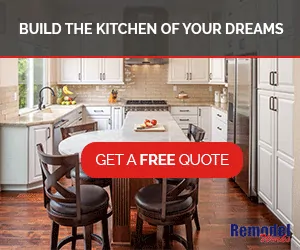
Bathroom Floor Types
In your home, your bathroom gets a lot of use. Specifically, the floor. So you need to make sure that your bathroom floor is durable, resilient, and waterproof. But that doesn’t mean that the aesthetic of your bathroom floor has to suffer.
In fact, there are numerous types of bathroom floor varieties, each one boasting unique benefits, drawbacks, and visual representations. Which one should you choose for you bathroom remodel? Use this complete guide to bathroom floor types to help you decide.
Vinyl Flooring
One of the original floor types for bathrooms is vinyl, which has been used in bathrooms for decades. Vinyl flooring is incredibly resilient, which is why it’s often used in heavy-traffic buildings like hospitals, grocery stores, and, of course, bathrooms. According to industry reports in Floor Covering Weekly, it has long been the most popular hard surface flooring in the United States.
Benefits of Vinyl
With several benefits, it’s easy to see why vinyl is so popular as a flooring option. First of all, vinyl is highly affordable: the average cost of linoleum and vinyl flooring is $2-$2.50 per square foot, but vinyl flooring can be found for as low as $0.50 per square foot. This makes vinyl a popular option with house-flippers, as well as homeowners on a budget.
In addition, vinyl flooring is highly customizable. There are actually three different kinds of vinyl flooring: sheet, plank or tile. Sheet vinyl offers the benefit of being cut in very large sizes. Small bathrooms may be able to be covered in just one large piece, with zero seams. And this can help save on material costs as well.
Vinyl plank flooring, specifically luxury vinyl plank flooring, has become increasingly popular choice in recent years. People are latching onto this trend because luxury vinyl plank flooring looks expensive and high-end without the scary price tag. In addition, even though many luxury vinyl plank flooring options look like wood or wood substitutes, they offer the benefit of being waterproof and scratch-resistant, which makes them a great choice for bathroom floors. LVP also offer the benefit of possible installation over existing flooring, which means less demo and shorter installation time.
If you want vinyl flooring in your bathroom, you will have no shortage of style, color and size to choose from, all at a reasonable price.
Drawbacks of Vinyl
Like any material, vinyl flooring in bathrooms has a few downsides as well. For example, it is affordable, but if you’re not careful with your selection, that cheap quality could come across in person. In addition, for homeowners, installing a flooring option like vinyl is probably not going to improve your property value (unless you go with luxury vinyl, which is increasingly attractive to homeowners today). And speaking of installation, vinyl can be difficult to install on your own – you will have to enlist the help of a professional.
Tile Flooring
Another historically popular choice for bathroom flooring is tile. There are two primary types of tile to choose from: ceramic and porcelain. These tiles can be used throughout the home, but the most popular rooms for tile installation are kitchens, entryways, and, of course, bathrooms. Ceramic and porcelain tile make a great option for bathroom flooring, but can also be used on countertops, as kitchen wall backsplashes, and with the shower/bath as well.
Benefits of Tile
Tile is perhaps one of the best possible materials to use when choosing a bathroom flooring since it’s waterproof, stylish, and highly versatile. This versatility is arguably the biggest advantage of tile flooring (over any other floor type). Tile offers a wide range of prices, styles, colors and patterns. You can create a classic look with white marble tile, bring the outside beauty of nature indoors with oceanic blue tile, or create something completely unique and original. Even after you choose your tile, there are more customization options based on how you choose to lay the pattern.
Tile is also very cost-effective bathroom flooring option: the average cost of ceramic or porcelain tile is $0.49 – $15 per square foot, depending on what quality you go for.
In general, tile looks great in any bathroom and is highly durable for years and years. With the right installation and consistent maintenance, a tile floor can last 20 years or more.
The difference between porcelain and ceramic tile comes down to water absorption rate, with porcelain boasting a lower water absorption rate (and usually a higher cost). Porcelain is also slightly harder than ceramic tile.
Drawbacks of Tile
Tile always looks great when installed as a bathroom flooring option, but part of this is because you pretty much have to hire a specialist to help with installation, which is an addition $4-$5 per square foot, on average. You can save money on your tile flooring installation by choosing a lower quality tile, but at that point, you are also risking durability.
Homeowners can save costs on installation by completing their own prep work (like removing the existing flooring), but if this isn’t in your wheelhouse, you’re definitely better off leaving it to the professionals.
In addition, depending on the tile you choose, it can become quite slippery when wet. Be sure to counteract this by choosing a tile with texture, especially on any walking surfaces.
Lastly, tile can be cold to walk on, even more so on cold mornings in winter! You can splurge for an under-floor heater, or a simpler solution is to integrate some rugs on your bathroom floor layout.
Stone Flooring
Stone flooring is a beautiful choice for bathrooms, especially for naturalists who want a Zen-inspired bathroom.
Advantages of Stone
Overall, stone flooring is highly durable, scratch-resistant, and is a home improvement that will help to increase the resale value of your home. It’s aesthetically pleasing and offers a rich, unique look in any home where it’s installed.
Functionally, the most popular stone flooring types, marble, granite, and limestone, are naturally resistant to water, and easily waterproof, so they make a great choice for bathroom flooring. You won’t have to worry about water damage or warping with a stone floor.
Drawbacks of Stone
Probably the biggest drawback of stone flooring, in general, is its price. Since stone is a natural material, it has to be harvested from nature, which isn’t a cheap process. Generally, stone flooring is the most expensive flooring option out there.
In addition, stone is, by nature, hard and cold, which can be uncomfortable underfoot. Despite being waterproof, stone can also be very slippery, so you must be very careful how and where you install it in your home.
Cork Flooring
In recent years, cork flooring has gained a lot of buzz among homeowners as a new, sustainable option for flooring in homes. Cork flooring is made from the bark of the cork oak tree: natural material is harvested from the tree, ground up, processed into sheets and baked in a kiln to create tiles.
Cork flooring has become very popular as a natural alternative to expensive flooring options like hardwood and can be frequently found in both homes and commercial locations alike.
Advantages of Cork
The most unique benefit of cork flooring is its sustainability. The cork oak tree is found in abundance in nature, and it’s easy to produce cork flooring efficiently and without any waste. Furthermore, there are highly regulated processes for harvesting the cork oak tree: harvesting is limited to nine-year cycles, and individual trees must be at least 25 years old before they are harvested. And, the bark of the cork oak grows back, so trees do not have to be destroyed to harvest the cork. In addition, the tiles are largely recyclable after use if the homeowner decides to take them out.
As far as installation and maintenance go, cork flooring is easy to install and easy to maintain. Cork is naturally moisture resistant, due to a natural component of the cellular makeup: a waxy material called suberin. Suberin also helps to make cork mold and mildew resistant, though it’s important to sweep and dust cork flooring regularly.
Cork flooring is soft underfoot and also has a natural warmth to it (unlike tile), which makes it a great choice for frequently occupied rooms.
Drawbacks of Cork
As mentioned above, cork flooring is naturally moisture-resistant. So it’s highly resistant to water, but not waterproof, which can be a tough battle for the bathroom area. Cork is another flooring option that may work well in powder rooms, but it probably not your best choice for highly-used bathrooms and bathing areas.
In addition, since cork flooring is natural wood, it’s not entirely scratch-resistant and is more susceptible to damage (especially from pet claws).
While no natural wood floor is entirely scratch-resistant, cork flooring is more adaptable to claws caused by dogs and cats than many other natural wood flooring options
Laminate Flooring
If you have your heart set on wood flooring (or the look of wood flooring) in your bathroom, your best bet is to go with laminate flooring. Laminate allows you to get the classic look of hardwood, without having to worry about water damage, malleability, or any of the other concerns commonly associated with hardwood.
Advantages of Laminate
The biggest advantage of laminate flooring is that it looks like the real deal: there are so many styles of laminate available today, that you can mimic the look and feel of almost any type of wood. Most laminates include the visual wood details and texture, color and graining, making it hard to tell the difference from the real thing!
Laminate is made from the layering of a number of different synthetic fabrics, usually resin and fiberboard materials, underneath a wood photographic applique, and a clear protective layer to top it all off and allow the wood visual to show through. According to HGTV, laminate is typically made from four layers of material that then gets fused together: “a melamine wear layer; a high-resolution photo of the surface it is emulating; a dense core board; and a melamine backing layer.”
Due to this structure, laminate helps you achieve the beauty of true hardwood at a fraction of the cost. Hardwood is known for being the most expensive flooring choice out there.
In general, laminate is affordable, durable, and resistant to stains and moisture, which makes it a great option for any home. It’s easy to clean, and highly customizable. It’s also hypoallergenic, and won’t harbor mold or mildew.
Drawbacks of Laminate
Because of the unique way that it’s constructed, laminate is a highly debated material for use in bathrooms, and as bathroom flooring.
The common agreement about laminate is that it can withstand water (it’s water-resistant), but don’t rely on it to be 100% waterproof. And definitely don’t leave puddles or other water residue sitting on laminate for long periods of time.
For these reasons, laminate is a great option for powder rooms, but for your primary bathroom where you (or your kids and family) use the shower, bath and more, you will probably want to go with a more solidly waterproof flooring choice.
Worst Floor Types for the Bathroom
Now that we’ve shared some viable bathroom flooring options, it’s also worthwhile to share a few flooring options that are not ideal for the bathroom.
Real Wood/Hardwood
Hardwood is a beautiful flooring option, but it has no place in the bathroom or any other room where water is frequently used. Hardwood is not waterproof and is highly susceptible to water damage. If even a small amount of water makes its way into the core of hardwood planks, it can rot the wood from the inside-out. Do yourself a favor and stay away from hardwood in the bathroom.
Carpet
We all know the feeling of tiptoeing your feet across a cold bathroom floor, but the solution to getting around this discomfort is not installing carpet in your bathroom. Carpet soaks up moisture, so if you place it in a room where there is constant wetness, you are setting yourself up for disaster.
Concrete
Concrete is a trendy floor option, but it’s not a great choice for bathroom flooring because it’s incredibly slippery, and by default can be very dangerous. If you want to see concrete in your bathrooms, consider a concrete countertop instead.
Wrapping Up
As you can see, there are a wide variety of flooring options for your bathroom. No matter your budget or the layout of your space, there is a type of floor that will fit your needs. For more information on bathroom remodels or kitchen remodels, please contact our San Diego home renovation company today.











